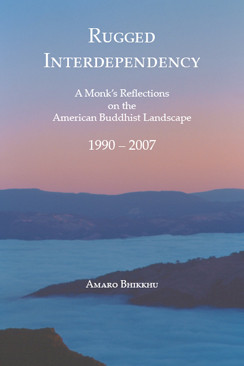Rugged Interdependency with the subtitle A Monk’s Reflections on the American Buddhist Landscape was written by Amaro Bhikku and published by the Abhayagiri Manostic Foundation. In the early 1980s Ajahn Sumedho began to make regular visits to northern California. He was the senior Western disciple of Ajahn Chah, one of the most highly respected Buddhist masters of the Thai forest tradition of Theravāda. Over the next ten years he developed a devoted following of students in the San Francisco Bay Area. In 1988 they formed the Sanghapala Foundation, with the mission of creating a branch Monastery of Ajahn Chah’s lineage somewhere in northern California. This is their story and the broader story about Buddhism in modern America:
Tracing the Path: A History of Buddhism in America
From its ancient roots in the East, Buddhism has found a unique expression in the cultural tapestry of the United States. Its journey highlights a blend of tradition and transformation, shaping and being shaped by the American experience. Here, we delve into the milestones that mark the history of Buddhism in America.
Arrival on Distant Shores (19th Century)
Buddhism’s American chapter began in the mid-1800s with the arrival of Chinese immigrants during the California Gold Rush. These pioneers brought with them traditional Mahayana Buddhist practices. However, these expressions of Buddhism stayed primarily within immigrant circles, influencing little of the broader cultural milieu of the time.
Parallel to this, the seeds of interest in Buddhist philosophy were sown in intellectual circles, thanks to the Transcendentalist movement. Figures like Henry David Thoreau and Ralph Waldo Emerson paved the way for a philosophical, if not religious, consideration of Buddhist ideas, extracted from primary texts and early translations.
Bridging Cultures: Expansion and Exchange (Late 19th & Early 20th Centuries)
The landscape shifted significantly in the late 19th century as Japanese immigrants, adherents of schools such as Jodo Shinshu, started to establish their communities and temples on American soil. Like their Chinese counterparts, their practice was communal and primarily insular.
A landmark event in the broader American engagement with Buddhism was the World Parliament of Religions in Chicago, 1893. The parliament served as a stage for the global exchange of spiritual ideas, introducing charismatic Buddhist thinkers to intrigued American audiences.
Counter-Culture and Spiritual Exploration (Mid-20th Century)
Post-WWII America brought about significant changes, with altered immigration policies leading to a more diverse Buddhist presence. Interest in Buddhism took on a distinctly counter-cultural tone in the 1950s and 1960s. The Beat Generation, with notable writers like Jack Kerouac and Allen Ginsberg, challenged the status quo, embracing aspects of Buddhist philosophy and aesthetics, particularly Zen’s esoteric allure.
American Buddhism: Identity and Practice (Late 20th Century)
By the late 20th century, the United States witnessed a flourishing and diversification of Buddhist traditions. Increased immigration from countries like Tibet, Thailand, and Vietnam introduced a wider array of practices. Notably, a uniquely American Buddhism began to emerge, characterized by a more eclectic and egalitarian approach, often decoupled from cultural ethnicity.
During this period, several American-born movements gained traction, emphasizing meditation, social justice, and psychological insights, resonating with the progressive values of a growing American audience.
The Present Landscape: Mindfulness and Beyond (Early 21st Century to Today)
In contemporary America, Buddhism enjoys a place as a recognized spiritual path among many. Its principles have permeated popular culture, and movements like mindfulness have introduced Buddhist-inspired meditation to the masses, often in secular contexts.
Today’s American Buddhism is engaged with modern societal issues, from environmentalism and social equality to mental health. It navigates the complexities of commercialization, authenticity, and the preservation of the rich heritage from which it springs.
Conclusion
Buddhism in America is a story of migration, transformation, and integration. Its history reflects America’s multifaceted culture, embodying the struggles and aspirations of individuals in search of spiritual meaning. As it continues to evolve, American Buddhism writes a unique chapter in the wider narrative of this ancient tradition, highlighting the universal quest for understanding and peace in an ever-changing world.
